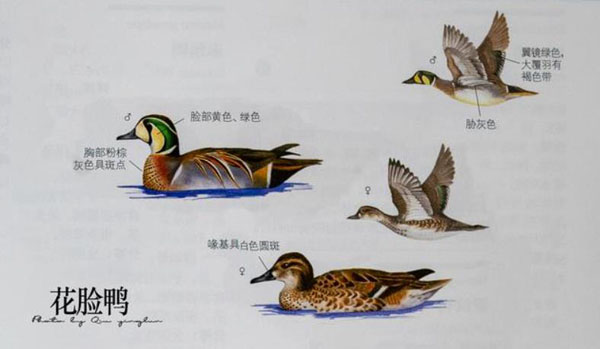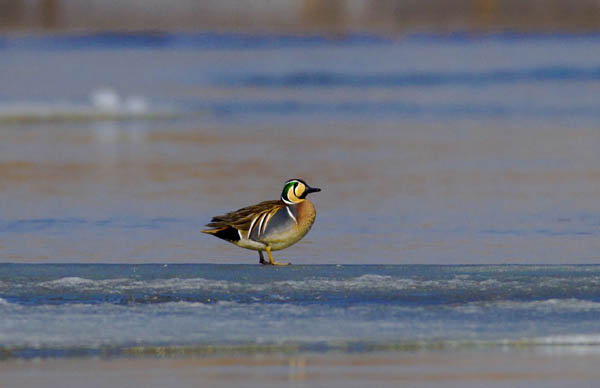Sibirionetta formosa
IUCN
LCBasic Information
Scientific classification
- name:Sibirionetta formosa
- Scientific Name:Ba duck, black-rimmed duck, spectacled duck, yellow-tipped duck, king duck, shaking duck, Yuan duck,Sibirionetta formosa,Baikal Teal
- Outline:Waterfowl
- Family:Anseriformes Anatidae Duck
Vital signs
- length:378-431mm
- Weight:360-520g
- lifetime:
Feature
The face is spotted with yellow, green, black, white and other colors, which is very eye-catching.
Distribution and Habitat
During migration in China, it passes through most of Northeast China and Central China, and winters in East China, Central China and South China, including Hainan Island and Taiwan Island. Abroad, it breeds in Northeast Asia and winters in East Asia.
During the breeding season, it mainly inhabits swamps, estuary deltas, lakes and ponds in the taiga or tundra zone. During the non-breeding season, it mainly inhabits various freshwater or saltwater waters, including lakes, rivers, reservoirs, ponds, swamps, river bays, farmland and other habitats.
Appearance
The male has a unique head pattern, with yellow front and dark green back, and a variety of colors including yellow, green, black, white, and brown. The upper back and flanks are blue-gray, the chest is reddish-brown with dark brown round spots, there is a vertical white stripe on each side of the chest and the base of the tail, the undertail coverts are dark brown, and the wing mirrors are green and stained brown. The female is dark brown with scaly patterns all over, the head is lighter in color, there is a white spot at the base of the beak, and there are crescent-shaped white patches on the sides of the face. The iris is brown, the beak is black, and the feet are gray-black.
Details
The Mandarin duck is a kind of duck that likes to gather in groups, especially in winter, and often gathers in large groups, and often mixes with other ducks. Individuals are slightly larger than green-winged teals, and slightly smaller than pintail ducks. The voice is noisy, and the call is loud and short, like "mog, mog" or "lok, lok", which can be heard from a long distance.

It mainly feeds on the buds, tender leaves, fruits and seeds of various aquatic plants such as sphaerocephala, caltrops, water grass, etc. It also often goes to the farmland after harvest to forage for scattered rice and grass seeds, and also eats small invertebrates such as snails, mollusks, and aquatic insects. It mainly forages at dusk and at night. It forages mostly by the water and nearby fields and farmland.
Every year, they start to migrate northward from their wintering grounds in southern China from early to mid-March, arrive in North China and Northeast China from mid-March to late March, and almost all leave China at the end of April. The spring migration period lasts for more than a month. In autumn, they enter Northeast China and North China in mid-September. A large number of migrations occur in mid-to-late October every year, and some stay in parts of Northeast China and North China as late as early November. The entire autumn migration period also lasts nearly 2 months. During migration, they often gather in large groups of dozens, hundreds, or even thousands of them.

Mainly breed in Siberia, pairs are formed when arriving at the breeding grounds, perhaps during the winter or on the way of spring migration. The breeding season is June-July. Usually, nesting begins soon after arriving at the breeding grounds, nesting on the ground and in the grass under willows or bushes, and also nesting on the ground beside ponds in small woods and on open tundra. The nest is a pit dug out of the ground, padded with dry reeds, hay and moss. After the incubation begins, the female bird plucks down feathers from her body and pads them in the nest. Each nest lays 6-10 eggs, which are light green-gray. The size is 46.2-47.7 mm × 33.7-35.7 mm, with an average of 47.1 mm × 34.4 mm. The incubation time is 21 to 25 days. The young birds leave the nest in 49 days, usually incubated by the female duck alone. After hatching, they are still cared for by the female duck, and the ducklings follow the female duck to find food.

The Mandarin duck was once one of the main hunting birds in China. The number is extremely abundant, especially in the Yangtze River Basin, and the annual hunting volume is extremely considerable. During the migration period, sometimes there are as many as 1,000-2,000 birds in groups. But it has become extremely rare. According to the Asian Midwinter Waterbird Survey organized by the International Waterfowl Research Bureau in 1990, the number of wintering populations in China was only 4,384. The population of Mandarin ducks in the world is also decreasing. For example, in southwestern Japan, in the early winter of 1947, three people hunted 50,000 Mandarin ducks, of which 10,000 were caught in one day, which shows how rich the population was at that time. However, in the Midwinter Waterbird Survey organized by the International Waterfowl Research Bureau in 1990, only 2,060 were seen in Japan. The global population of Mandarin ducks is about 50,000. The main reason for the population decline is overhunting.
Listed in the second level of China's "National Key Protected Wildlife List" (February 5, 2021).








